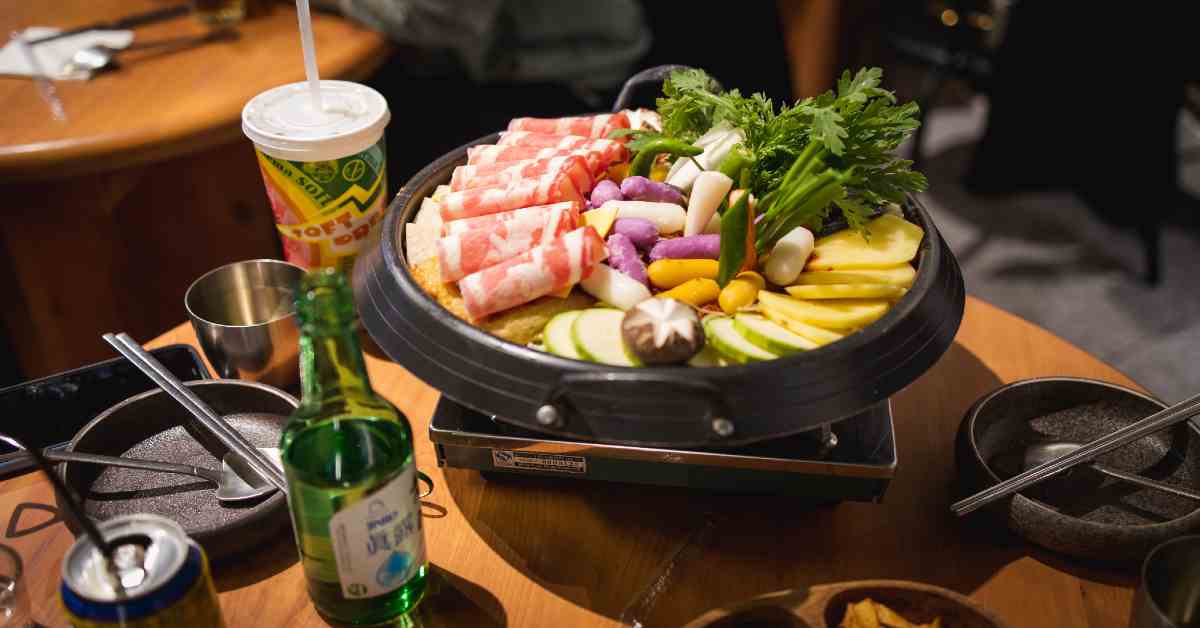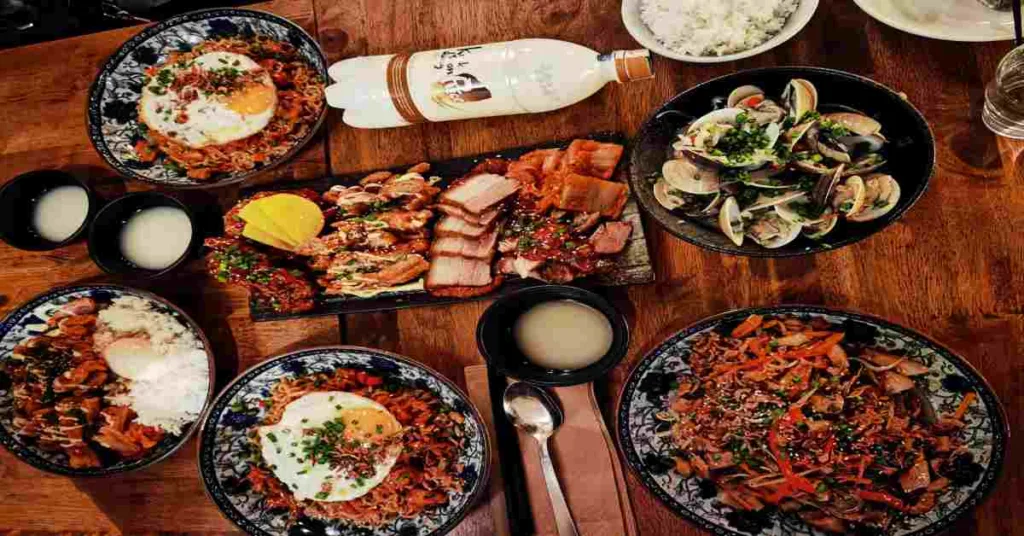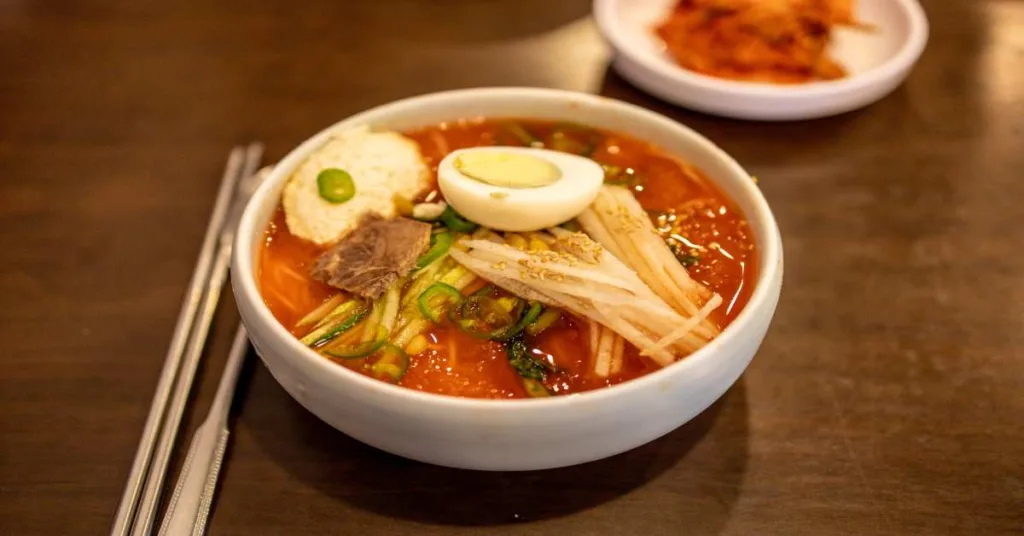Know about Kimchi Jjigae ( Korean Stew) Famous Korean food
This simple kimchi stew dish with pork and tofu will bring the wave of Korean dramas right into your home! This well-liked meal from Korea, kimchi jjigae, is rich and flavorful to die for! An all-in-one bowl of soup that is savoury, tart, sweet, and hot!
Content Kimchi Jjigae(Korean Stew):
- What is Jjigae?
- Varieties of Jjigae
Kimchi Jjigae (Kimchi stew)
- What is Kimchi jjigae?
- Recipe
- Varieties of Kimchi jjigae
Sundubu Jjigae (Soft tofu stew)
- What is Sundubu jjigae?
- Recipe
- Difference between Sundubu & Kimchi jjigae
Budae Jjigae (Army stew)
- What is Budae jjigae?
- Recipe
Doenjang Jjigae (Soybean paste stew)
- What is Doenjang jjigae?
- How to serve?
- Recipe
What to serve with Jjigae?
What is Jjigae?
A typical spicy Korean stew known as jjigae is typically made of dubu (tofu), veggies, mushrooms, shrimp, beef, pork, and gochujang (chilli paste). According to the chef and region, some ingredients may be substituted, added, or eliminated. In a broth seasoned with hot pepper paste (gochujang), fermented miso (Gaenjang), soybean paste, or salted fermented shrimp, a typical Korean stew will include meat, fish, or vegetables (Saeujeot).
Jjigae comes in a wide range of variations. Budae jjigae (army stew), which includes bacon, sausages, and Spam meat as well as Ramyeon noodles and rice cakes blended with gochujang paste for a spicy flavour, is one of the most well-known jjigae dishes in Seoul. A stew is a mixture of components that are solid foods, cooked in liquid and eaten with the resulting gravy.
Despite the fact that there are many variations, traditionally, a raw egg is placed on top of the stew and mixed with the broth before serving to give the food tasty.
Jjigae is typically served hot and in a communal dish. The rice and Kimchi are served with stew in a sizable stone bowl.
Varieties of Jjigae
The several kinds of jjigae are frequently referred to by their main ingredients, such as Saengseon jjigae, which is made of fish, or by their broth and seasonings, such as doenjang jjigae or gochujang jjigae, which is made of tofu.
Any mix of vegetables, as well as meat (particularly harder meats appropriate for wet slow cooking), seafood, or a combination of these, can be used as ingredients in a stew.
This is the list of some Jjigae;
- Kimchi Jjigae (Kimchi stew)
- Sundubu Jjigae (Soft tofu stew)
- Budae Jjigae (Army stew)
- Doenjang Jjigae (Soybean paste stew)
Kimchi Jjigae (Kimchi Stew)
The stew based on kimchi is known as kimchi jjigae. The classic dish kimchi jjigae evokes memories of childhood for all Koreans. People frequently prepare this stew since it is a mainstay of Korean home cooking.
Although there are many different kimchi jjigae recipes where, pork, kimchi, and tofu are used most frequently. Pork kimchi jjigae most frequently employs fatty pork chunks, like pork belly or pork shoulder. However, regional differences may specify a wide range of meat or seafood choices.
Another meatless option for this delectable stew is vegetarian kimchi jjigae made with mushrooms. Kimchi used for kimchi jjigae is partially fermented because the different flavours are improved more than when kimchi is made freshly.
Recipe
Ingredients: Sesame oil, garlic, onions, pork belly, kimchi, its brine, stock, gochujang (Korean red pepper sauce), salt, sugar, firm tofu, and scallions.
Step 1: Heat the oil in a pot over medium-high heat, add the onions, garlic, and pork belly, and cook for 5 minutes, or until the pork is no longer red.
Step 2: Include the chopped kimchi and its brine. 2 minutes of simmering. Add sugar, gochujang, and broth into the container. Add salt, then boil for ten minutes.
Step 3: Topped with thinly sliced firm tofu and scallions. Sprinkle in a little sesame oil, cover the pan, and boil for two minutes.
Step 4: Serve it hot.
Tips
- Use extremely old, sour cabbage kimchi since it is a terrific way to use up surplus kimchi that has been taking up space in the fridge.
- Pork tastes better the fattier it is. Fat develops taste. Use pork belly or pork shoulder with a coating of fat on, if possible.
- Don’t forget the kimchi juice (or kimchi liquid). It is delicious and gives your Jjiage more flavour depth.
- Kimchi jjigae’s flavour is enhanced by a dash of Korean salted shrimp.
- To thicken the stew broth, add a few rice cake pieces. This is optional, though.
- Pork kimchi stew made with plain water instead of anchovy stock is preferable. It better preserves the pork’s original flavour.
Varieties of Kimchi Jjigae
There are numerous ways to create kimchi stew. The most typical would be kimchi jjigae with pork, but other variations are also well-liked in Korean home cooking.
- Pork kimchi stew (Dueji kimchi jjigae): This traditional kimchi stew is made with tofu and fatty bits of pork.
- Tuna kimchi stew (Chamchi kimchi jjigae): This stew benefits from canned tuna. Due to its simplicity and portability, tuna kimchi jjigae is frequently made on camping trips (no refrigeration is needed for the ingredients).
- Mackerel pike is used to make the kimchi stew known as Kkongchi kimchi jjigae.
- Fish cake kimchi stew (Eomuk kimchi jjigae): This dish is made with anchovy broth, Korean fish cakes, and kimchi.
- Spam kimchi stew: This quick and easy recipe creates another delectable Kimchi stew using a can of spam.
- Myulchi kimchi jjigae, also known as anchovy kimchi stew, is a traditional kimchi dish from the southern region of South Korea. It is created with perilla oil and dried anchovies.
Sundubu Jjigae (Soft tofu stew)
A spicy Korean tofu stew known as Soondubu jjigae is created with Soondubu, newly soft tofu. For a filling, delectable lunch, you can add a variety of veggies and proteins to this Korean tofu stew, including mushrooms, onions, zucchini, shellfish, chicken, pork, beef, and shrimp. Chopped kimchi is almost often added to the stew to give it more flavour.
Cooking Korean tofu soup in an earthenware pot and adding a freshly cracked egg just before serving is customary. The Soondubu jjigae should remain hot and boiling due to the heat from the earthenware pot, which will result in an egg that is nicely poached. If you don’t like seafood, you can substitute beef, pork belly, or mushrooms.
With this classic dish, you may have silken tofu that is silky soft and seasoned with a rich, spicy stew. Take full advantage of this delicious Korean tofu soup.
Recipe
Ingredients: Soft tofu, garlic, salt, pepper, mushroom, eggs, stock, Gochugaru, sugar, sesame oil, and onion.
Step 1: Kimchi, onions, garlic, Korean red pepper flakes, and the protein of choice are stir-fried for three minutes in a pot. After that, add the soft tofu and gently separate it.
Step 2: Bring to a boil after adding the stock. Depending on how salty and fermented the kimchi is, taste it and season with salt and sugar. Kimchi’s tartness is balanced by the sugar.
Step 3: Boil for 3 minutes after adding the mushroom and egg mixture. Add toasted sesame oil and green onions as garnish. Enjoy with rice after serving!
Tips
- For the finest flavour, use well-fermented or ripe kimchi. Don’t forget to include kimchi juice as well.
- To replicate the flavour of traditional Soondubu served in Korean restaurants, use dashi or anchovy stock.
- For a nicely poached egg, add one egg for 3 to 4 minutes before serving. The egg is continued to simmer in an earthenware pot (Ttukbaegi) to produce a lovely soft-boiled egg.
Difference between Sundubu Jjigae & Kimchi Jjigae
Although a small bit of sour kimchi is required in many Soondubu jjigae recipes, it is not a necessary component, so you are free to skip it.
Kimchi and fatty pork are the key ingredients of kimchi jjigae, which also includes a few pieces of tofu to give the stew some more heartiness.
Budae Jjigae (Army stew)
Budae Jjigae is one of Korea’s most popular comfort dishes, also known as army stew, is constantly at the forefront of cravings, especially during the colder seasons. It is a fusion cuisine that was created soon after the Korean War (in the early 1950s), while the American troops were based in Uijeongbu, a city that is located an hour north of Seoul.
Food was particularly short for the villagers when the Korean War ended in 1953. The only materials left over from American military bases were food supplies, which were swiftly gathered by the local Koreans to make up for their food deficit. They made a nourishing stew for their families out of all the available items, combining kimchi, garlic, and Korean chilli paste with spam, sausages, canned beans, and sliced cheese from the United States.
One of the most famous dishes in Korean cuisine and one that combines everything Koreans love in one meal, army stew has a rich history and seductive tastes that will immediately warm your mouth.
It also makes for the ideal hot pot dish to share around the table with your loved ones (using a portable stove), making it the ideal holiday meal to enjoy and one that requires little work to prepare.
This thick and flavorful Budae Jjigae is best served with a bowl of hot rice and is packed with spam, sausages, tofu, kimchi, and Ramyeon noodles. The ideal supper to enjoy with your loved ones is this hearty stew, which is wonderfully easy to prepare.
The kimchi and instant ramen noodles in this recipe give it a distinctively Korean flavour while using canned processed meats like Spam.
Recipe
Ingredients: Spam(core ingredients of this stew), Sausages, Mushrooms, Rice cakes, Tofu, Onions, Ramyeon, Kimchi, and Cheese.
For Sauce: Gochugaru, Soy sauce, Pepper, Garlic, Chicken broth, Mirin, Gochujang.
Additionally, napa cabbage, fish cakes, baked beans, bean sprouts, macaroni, eggs, and Dangmyeon are frequently included (sweet potato noodles).
You can also add other vegetables that are perfect for the hot pot to the mixture, such as spinach, bok choy, and watercress, to counteract the fatty pork.
Step 1: Combine all the sauce ingredients in a small bowl.
Step 2: In a small pot, combine the spam, tofu, mushrooms, sausages, rice cakes, onion, and kimchi.
Step 3: Over medium-high heat, add the sauce and chicken broth, cover, and bring to a boil.
Step 4: When the stew comes to a boil, reduce the heat to medium and cook for about 5 minutes. When the noodles are fully cooked, add the cheese and simmer for an additional 3–4 minutes.
Step 5: Serve with a dish of steaming rice and green onions as a garnish. Enjoy!
Tips:
- If you prefer the more conventional tastes, you can also use dashi, Korean beef bone broth, or anchovy stock.
- If you don’t have mirin, just add some sugar to the mixture to soften the hot flavours.
- Depending on your preferences, you can add bacon, pork belly, spam, ham, or hot dogs.
- If you’re using frozen rice cakes, simply thaw them in water by soaking them for 5 to 10 minutes while you prepare the other ingredients.
- Prepare your army stew on a portable burner directly at the table, and while it simmers, let guests choose what they would like to eat. (The majority of the components cook quickly.)
- Instant ramen noodles should be consumed as soon as possible after cooking because they quickly get mushy.
- While eating, have extra soup stock and jjigae ingredients close by so you can top off the stew if it becomes low.
- Use a big, shallow pan to prepare your Budae jjigae so that it can accommodate all of the jjigae ingredients.
Doenjang Jjigae (Soybean paste stew)
This traditional doenjang jjigae recipe employs fermented Korean soybean paste to make a richly fragrant stew that is complemented by tofu and fresh veggies.
Perhaps the most popular stew in Korea, along with kimchi jjigae, is a pot of hot, bubbling doenjang jjigae.
It’s safe to say that most Koreans grew up eating this stew at least once or twice a week.
Although homemade doenjang jjigae made with this paste would be the best, store-bought Korean soybean paste can still be used to make a tasty stew. In any case, it is a crucial component of Korean cuisine.
Don’t miss this perennially popular Korean soybean paste stew if you like Korean soups and stews.
How to serve?
Ttukbaegi is a type of Korean earthenware that is created from a particular clay and is frequently glazed on the inside for cooking. Onggi, a type of unglazed Korean earthenware, is typically used to preserve food. Doenjang jjigae is cooked in a Ttukbaegi, which retains heat well and keeps the stew hot for a longer period of time. Ttukbaegi preserves the authentic flavour of fermented food during cooking without the intrusion of metallic surfaces on other types of cookware.
Recipe
You’ll need Korean soybean paste (doenjang) to make authentic doenjang stew, without a doubt. Try sprinkling some Korean chilli paste on top of that (gochujang).
A modest spoonful of gochujang will give your stew depth, despite its strange-sounding appearance. Additionally, the stew gets a little bite from some Korean chilli flakes.
Ingredients: Korean soyabean paste, gochujang, gochugaru
Other options: onion, zucchini, tofu, mushroom, fresh chilli, thin slices of beef or pork, clam, shrimp, crab, watercress, radish, potato, mushroom, bean sprouts, kale, turnip green, etc.
Step1: Prepare the Stock
All you need to do is cook dried anchovies for three to four minutes in rice water (rice starch water), along with a piece of dried sea kelp. Your stock is ready when the anchovies and sea kelp are thrown away.
Step 2: Korean soybean paste and chile paste should be added to the finished anchovy stock.
Step 3: Over medium heat, add the onion and gently bring it to a boil.
Step 4: Add the mushroom and zucchini when it is ready to boil, and then continue to boil them on medium-low heat.
Step 5: Add garlic, Korean chilli flakes, and fresh chilli slices at the end of cooking.
Step 6: Last but not least, remove the pan from the heat and add the green onion. A pot of sizzling hot Korean stew is ready to be served.
Tips:
- Start with quality stock, usually anchovy stock, for a good doenjang jjigae. Make your base out of rice starch water rather than regular water.
- To put it simply, the water you used to rinse the rice is rice starch water. The stew will become thicker and more flavorful due to the addition of starch. Use plain water instead if you like your stew thinner.
What to serve with Jjigae?
The stew itself is delicious and filling. Serve this dish with rice and pair
it with one or two Korean side dishes to enjoy.
If you want to add then these are some side dishes which go well with Jjigae
- Korean Spinach (Sigeumchi Namul)
- Bean sprout salad
- Korean potato side dish
- Korean cabbage with soybean paste
- Homemade roasted seaweed snack
- Korean Zucchini banchan
Related Content Famous Korean Food (Follow the link)


